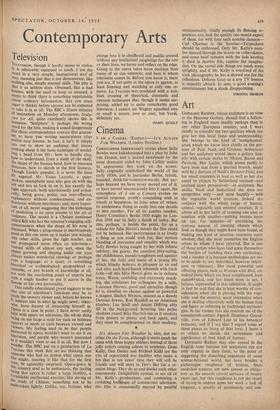ContempOrary Arts
Television
fit.evisioN, though it hardly seems to realise it, is admirably equipped to teach. I use \the word in a very simple, instructional sort of way, meaning just that it can demonstrate, like nothing else, simple manual skills. The pity is that it so seldom does. Obsessed, like a bad hostess, with the need to keep us amused, it seems to think there is something unpalatable about ordinary information, that you must sugar it thickly before anyone can be expected to take it in at all. The BBC's fifteen minutes of instruction on Monday afternoons, Scutt,- tare for All, quite excellently shows this is nonsense. 'Sculpture' is perhaps the wrong Ward for the title, making it sound dangerously like those correspondence courses that guaran- tee to have you writing masterpieces after twelve easy lessons. In fact, it isn't, It simply Sets out to show an audience that knows nothing about it the basic technique of model- ling a head from life : 'how to handle clay, how to understand, from a study of the skull, the shape of the human head, how to measure distances, how to sketch in the first features. Though frankly popular, it is never the least bit sugared. Mr. Vasco Lazzolo, a quiet- Poken, unemphatic man who gets on with the job and lets us look in on it, has exactly the right approach, both televisionally and artisti- cally, being grave, polite, not over-effusive, explanatory without condescension, and en- thusiastic without heartiness; and, most impor- tant of all, never suggesting that the technique of modelling is an open sesame to the art of sculpture. The model is a Chelsea pensioner called Bill who has the amateur's engaging self- consciousness when the shape of his nose is discussed. When a programme as unobtrusively good as this one turns up it makes you wonder why other skills, given, the right teacher, are not propagated more often on television— manual skills of almost any sort, since the object growing and shaping under our eyes always makes wonderful viewing; or perhaps ?Yen a language; or a sport; or something historical or archaeological, geographical or scientific, or any branch of knowledge at all, not with the everlasting panel of experts but With a single teacher to put it across in the flavour of his own personality. This mildly educational rood suggests to me that one of television's functions may be to catch the unwary viewer and, before he knows 1% Interest him in what he might never, other- „wise, have dreamt of interesting himself in. uPera is a case in point. I have never really held with opera on television, the whole thing Being on ton large a scale for such an intimate raPPort as needs to exist between viewed and viewers. My feeling used to be that people interested in opera wouldn't want to see it on
i
television, and people who weren't interested 11I t wouldn't want to see it at all. But now I wonder. The BBC put on a production of La 7raviata this week that set me thinking that someone who had no notion what opera was like might, meeting it like that for the first time, be agreeably surprised. Opera-goers in being Country tend to be enthusiasts, the feeling 'cing that opera is rather a large liability, a formidable intellectual exercise; like ski-ing or the study of Chinese, something not to be undertaken lightly. Unlike, say, Italians, who plunge into it in childhood and paddle around without any intellectual misgivings for the rest or their lives, we hover and reflect on the edge. Going to the opera takes more decision than many of us can summon; and here' is where television comes in. Before you know it, there you are, if not quite at the opera in person, at least listening and watching at only one re- move. La Traviata was produced with a bril- liant crossing of theatrical, cinematic and operatic techniques that, though it seems sur- prising, added up to quite remarkably good television. I cannot see Wagner squashed into so small a screen, now or ever, but Verdi, definitely yes.
ISABEL QUIOLY










































 Previous page
Previous page